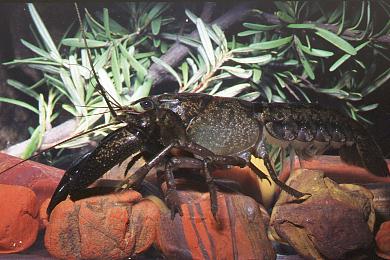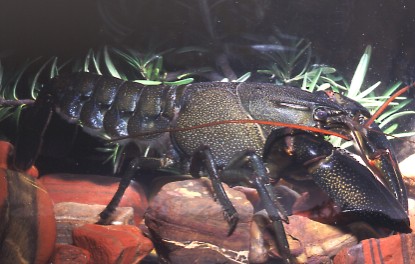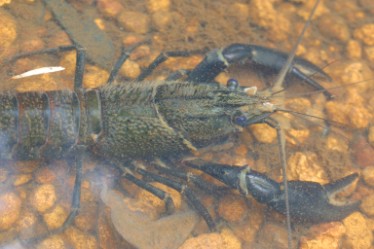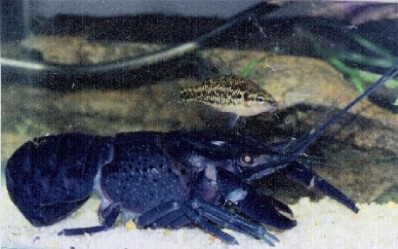South-western Australia has the world's third largest crayfish!
All eleven naturally occurring species of freshwater crayfishes in W.A. are endemic to the south-west and none naturally occur in the Pilbara or Kimberley. Six species belong to the Cherax genus and five to the burrowing Engaewa genus. A twelfth species is the introduced Yabby Cherax destructor, which has colonised many wild systems and poses a serious threat to the native species and aquatic ecosystems. Below we provide a summary of these fascinating decapod crustaceans and also provide an identification key to distnguish between the species of Cherax.
Cherax species
These species are found in a broad range of freshwater habitats throughout the south-west including rivers, streams and wetlands. The species include the Smooth Marron Cherax cainii, the Critically Endangered (EPBC Act 1999) Margaret River Hairy Marron Cherax tenuimanus (up until 2002, this name was assigned to the Smooth Marron but when the Hairy Marron was given species status by Austin and Ryan (2002) the name was assigned to it and the Smooth Marron was formally described as C. cainii), Gilgie Cherax quinquecarinatus, Koonac Cherax preissii, Restricted Gilgie Cherax crassimanus, and the restricted Cherax glaber.
Apart from the two species of marron, these species can also exist in streams and wetlands that are seasonally dry as they burrow into the water table. The trophic role of freshwater crayfish varies but they are usually omnivorous detrtivores that can consume large amount of dead and decaying organic material. They may also feed on aquatic vegetation and can actively predate on other aquatic invertebrates and even fish.
In south-western Australia, aquatic ecosystems have a naturally low Instream productivity and rely mostly on external sources of energy, such as terrestrial vegetation, entering the ecosystem (known as ‘allochthonous’ energy sources). Through their feeding habitats, freshwater crayfish can play an importance role in processing these terrestrial energy sources. Their important role in aquatic ecosystems results in them often being considered keystone species.
Engaewa species
The Engaewa are a highly restricted group being found mostly in the coastal region from Walpole to Dunsborough. These species include the Dunsborough Burrowing Crayfish (E. reducta listed as Critically Endangered under the EPBC Act 1999), the Magaret River Burrowing Crayfish (E. pseudoreducta listed as Critically Endangered under the EPBC Act 1999), the Walpole Burrowing Crayfish (E. walpolea listed as Vulnerable under the EPBC Act 1999) E. similis and E. subcoerulea. They are obligate burrowers and spend almost their entire life-cyle underground in complex burrow systems in vegetated habitats with access to the water table. Much of the research into the Engaewa has been conducted by Edith Cowan University and there is also a DEC Recovery Plan for several species.
Threats to south-west crayfish
facing the unique freshwater crayfishes of the south-west are similar to those impacting the native freshwater fish. These include secondary salinisation of inland reaches of rivers that has reduced the inland range of many crayfish species. They are also impacted by introduced predatory fish, particularly Redfin Perch, but are also predated by stocked Trout.
Reductions in aquatic habitat availability due to the severe reductions in rainfall (~15%) and annual runoff (up to 50%) since the 1970's is exacerbating other impacts. Based on CSIRO predictions, by 2030 additional reductions in annual rainfall in south-western Australia will lead to further reductions in groundwater levels and surface runoff and therefore it is crucial we do all we can to address these other threats to help conserve these unique species.
Crayfish information contact:
s.beatty@murdoch.edu.au
Recent publications
Marron reproductive biology paper
Marron population biology paper
Introduced Yabbies in Western Australia
Ecological roles and resource overlap of Yabbies and Marron
Freshwater crayfish in the Blackwood River
Introduced Redclaw Crayfish in Western Australia
Some classic Smooth Marron habitats: top is the Blackwood River, and bottom is the Warren River (one of the sites studied as part of the Marron FRDC 2003/027 project). Photos S. Beatty
A female Smooth Marron with juveniles on its pleopods. See the paper on the Reproductive biology of the Smooth Marron. Photo: S. Beatty
Commonly encountered Cherax species in the south-west

Guess which one is the Gilgie Cherax quinquecarinatus?. ........................they both are! The colour variation between populations and even within populations of the Gilgie is astonishing. Photos D. Morgan

Koonac Cherax preissii Photo D. Morgan
Smooth Marron Photo: D. Morgan

The critically endangered Margaret River Hairy Marron Cherax tenuimanus Photo: Simon Visser

A brilliant blue variation in colour of the Smooth Marron, pictured here with a Western Pygmy Perch.
Key to the freshwater crayfishes of south-western Australia
(Adapted from Horwitz, 1995) Engaewa species not included
1a. Very short, rounded rostrum usually spineless, post orbital ridges absent or greatly reduced, tail entirely calcified, claw articulates (pinches) on a vertical plane......................................................................................................Obligate burrowing crayfish Engaewa spp.
1b. Post orbital ridges present, posterior half of telson membranous....................................................................Cherax spp. .....Go to 2
2a. Setae present on arm (merus) and wrist (carpus)….................................................................................Feral Yabby C. destructor
2b. Setae absent on arm and wrist (setae may be present on the edge of propodal palm)..............................................................Go to 3
3a. Spines present on the dorsal surface of telson…………......……………..................................................................................Go to 4
3b. Spines absent on the dorsal surface of telson……………......................................................................................................Go to 5
4a. Obvious setae present on the cephalothorax (head region) of larger individuals, central longitudinal ridge extending to cervical groove.......................................................................................................................Margaret River Hairy Marron C. tenuimanus
4b. Obvious setae absent on the cephalothorax of larger individuals, central longitudinal ridge not extending to cervical groove…………....................................................................................................................................... Smooth Marron C. cainii
5a. Five longitudinal ridges present (central ridge may be reduced) on dorsal side of head (cephalon) (C. crassimanus sometimes has these ridges but are more reduced), two pairs of spines on rostrum (compared to no spines on C. preissii) and the spine on inner edge of wrist moderately curved and relatively blunt (compared to C. crassimanus)………………………………......….…….Gilgie C. quinquecarinatus
5b. Post-orbital ridges and rostral carinae on dorsal side of head reduced and central longitudinal ridge usually absent or greatly reduced such that usually two ridges present on head, relatively short rostrum…............................................................................................................................................................................Go to 6
6a. Dorsal surface of head lacks fine punctuations to give a shiny appearance ……....…...........................................................…C. glaber
6b. Fine punctations present on dorsal surface of head to give a ‘mat’ appearance..........................................................................Go to 7
7a. Similar appearance to the Gilgie (may have a reduced central longitudinal ridge present on dorsal side of head), small sharply curving spine on inner edge of wrist (Gilgie and Koonac moderately curved and relatively blunt), often with distinctive orange relatively small maximum size (usually <30 mm OCL, 70 mm total length)....................................................................................Restricted Gilgie.C. crassimanus
7b. Central longitudinal ridge usually completely absent, short rostrum, large maximum size (up to 200 mm OCL), relatively broad, spade-like claws……………...............................................................................................................................................Koonac C. preissii
Additional reading:
Austin, C. M., and Knott, B. (1996). Systematics of the freshwater crayfish genus Cherax Erichson (Decapoda: Parastacidae) in south-western Australia: Electrophoretic, Morphological and Habitat Variation. Australian Journal of Zoology 44, 223–58.
Austin, C. M., and Ryan, S. G. (2002). Allozyme evidence for a new species of freshwater crayfish of the genus Cherax Erichson (Decapoda: Parastacidae) from the south-west of Western Australia. Invertebrate Systematics 16, 357–67.
Beatty, S. J. (2006). The diet and trophic positions of translocated, sympatric populations of Cherax destructor and Cherax cainii in the Hutt River, Western Australia: evidence of resource overlap. Marine & Freshwater Research 57(8): 825-835.
Beatty, S.J., Morgan, D.L. & Gill, H.S. (2003). Reproductive biology of the large freshwater crayfish Cherax cainii in south-western Australia. Marine & Freshwater Research 54: 597-608.
Beatty, S.J., Morgan, D.L. & Gill, H.S. (2004). Biology of a translocated population of the large freshwater crayfish, Cherax cainii Austin & Ryan, 2002 in a Western Australian river. Crustaceana 77(11): 1329-1351.
Beatty, S.J., Morgan, D.L. & Gill, H.S. (2005). Life history and reproductive biology of the gilgie, Cherax quinquecarinatus, a freshwater crayfish endemic to southwestern Australia. Journal of Crustacean Biology 25(2): 251-262.
Beatty, S.J., Morgan, D.L. & Gill, H.S. (2005). Role of life history strategy in the colonisation of Western Australian aquatic systems by the introduced crayfish Cherax destructor Clark, 1936. Hydrobiologia 549: 219-237.
Horwitz, P. (1990). The translocation of freshwater crayfish in Australia: Potential impact, the need for control and global relevance. Biological Conservation 54, 291–305.
Horwitz, P. (1995). 'A preliminary key to the species of Decapoda (Crustacea: Malocostraca) found in Australian inland waters. Identification guide number 5.' (Co-operative Research Centre for Freshwater Ecology: Albury, New South Wales.
Horwitz, P., and Adams, M. (2000). The systematics, biogeography and conservation status of species in the freshwater crayfish genus Engaewa Riek (Decapoda: Parastacidae) from south-western Australia. Invertebrate Taxonomy 14, 655–80.
